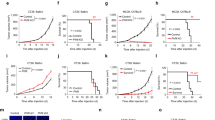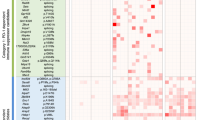Abstract
Avoiding immune destruction is essential for tumorigenesis. Current research into the interaction between tumor and immunological niches complement tumor pathology beyond cancer genetics. Intrinsic host defense immunity is a specialized innate immunity component to restrict viral infection. However, whether intrinsic immunity participates in tumor pathology is unclear. Previously, we identified a zinc-finger antiviral protein ZAP that is commonly downregulated in a panel of clinical cancer specimens. However, whether ZAP has an impact on tumor development was unknown. Here we report ZAP as a genuine tumor suppressor. Pan-caner analysis with TCGA data from 712 patients and large-scale immunohistochemistry in tissue microarrays from 1552 patients reveal that ZAP is prevalently downregulated, and associated with poor survival in liver, colon, and bladder cancer patients. Ectopic over-expression of ZAP inhibits the malignant phenotypes of colorectal tumor by cell cycle arrest. Using RNA immunoprecipitation and RNA decay assays, we demonstrate that ZAP directly and specifically binds to and degrades the transcript of TRAILR4, which in turn represses TRAILR4 expression and inhibits the aggressiveness of colorectal cancer cells. Furthermore, our CRISPR-engineered mice models show that loss-of-function of ZAP synergizes with APC-deficiency to drive malignant colorectal cancer in vivo. Overall, we identify a previously unknown function of the antiviral factor ZAP in colorectal tumorigenesis, linking intrinsic immunity to tumor pathogenetics.
This is a preview of subscription content, access via your institution
Access options
Subscribe to this journal
Receive 50 print issues and online access
$259.00 per year
only $5.18 per issue
Buy this article
- Purchase on Springer Link
- Instant access to full article PDF
Prices may be subject to local taxes which are calculated during checkout





Similar content being viewed by others
References
Hanahan D, Weinberg RA. Hallmarks of cancer: the next generation. Cell. 2011;144:646–74.
Ribas A. Adaptive immune resistance: how cancer protects from immune attack. Cancer Discov. 2015;5:915–9.
Feng M, Jiang W, Kim BYS, Zhang CC, Fu YX, Weissman IL. Phagocytosis checkpoints as new targets for cancer immunotherapy. Nat Rev Cancer. 2019;19:568–86.
Ribas A, Wolchok JD. Cancer immunotherapy using checkpoint blockade. Science. 2018;359:1350–5.
Thorsson V, Gibbs DL, Brown SD, Wolf D, Bortone DS, Ou Yang TH, et al. The immune landscape of cancer. Immunity. 2018;48:812–30. e814.
Munoz-Fontela C, Mandinova A, Aaronson SA, Lee SW. Emerging roles of p53 and other tumour-suppressor genes in immune regulation. Nat Rev Immunol. 2016;16:741–50.
Textor S, Fiegler N, Arnold A, Porgador A, Hofmann TG, Cerwenka A. Human NK cells are alerted to induction of p53 in cancer cells by upregulation of the NKG2D ligands ULBP1 and ULBP2. Cancer Res. 2011;71:5998–6009.
Yoon KW, Byun S, Kwon E, Hwang SY, Chu K, Hiraki M, et al. Control of signaling-mediated clearance of apoptotic cells by the tumor suppressor p53. Science. 2015;349:1261669.
Snell LM, McGaha TL, Brooks DG. Type I interferon in chronic virus infection and cancer. Trends Immunol. 2017;38:542–57.
Parker BS, Rautela J, Hertzog PJ. Antitumour actions of interferons: implications for cancer therapy. Nat Rev Cancer. 2016;16:131–44.
Zitvogel L, Galluzzi L, Kepp O, Smyth MJ, Kroemer G. Type I interferons in anticancer immunity. Nat Rev Immunol. 2015;15:405–14.
Dunn GP, Koebel CM, Schreiber RD. Interferons, immunity and cancer immunoediting. Nat Rev Immunol. 2006;6:836–48.
Lin Y, Zhang H, Liang J, Li K, Zhu W, Fu L, et al. Identification and characterization of alphavirus M1 as a selective oncolytic virus targeting ZAP-defective human cancers. Proc Natl Acad Sci USA. 2014;111:E4504–12.
Bick MJ, Carroll JW, Gao G, Goff SP, Rice CM, MacDonald MR. Expression of the zinc-finger antiviral protein inhibits alphavirus replication. J Virol. 2003;77:11555–62.
Chiu HP, Chiu H, Yang CF, Lee YL, Chiu FL, Kuo HC, et al. Inhibition of Japanese encephalitis virus infection by the host zinc-finger antiviral protein. PLoS Pathog. 2018;14:e1007166.
Gao G, Guo X, Goff SP. Inhibition of retroviral RNA production by ZAP, a CCCH-type zinc finger protein. Science. 2002;297:1703–6.
Guo X, Carroll JW, Macdonald MR, Goff SP, Gao G. The zinc finger antiviral protein directly binds to specific viral mRNAs through the CCCH zinc finger motifs. J Virol. 2004;78:12781–7.
Guo X, Ma J, Sun J, Gao G. The zinc-finger antiviral protein recruits the RNA processing exosome to degrade the target mRNA. Proc Natl Acad Sci USA. 2007;104:151–6.
Lee H, Komano J, Saitoh Y, Yamaoka S, Kozaki T, Misawa T, et al. Zinc-finger antiviral protein mediates retinoic acid inducible gene I-like receptor-independent antiviral response to murine leukemia virus. Proc Natl Acad Sci USA. 2013;110:12379–84.
Liu CH, Zhou L, Chen G, Krug RM. Battle between influenza A virus and a newly identified antiviral activity of the PARP-containing ZAPL protein. Proc Natl Acad Sci USA. 2015;112:14048–53.
MacDonald MR, Machlin ES, Albin OR, Levy DE. The zinc finger antiviral protein acts synergistically with an interferon-induced factor for maximal activity against alphaviruses. J Virol. 2007;81:13509–18.
Mao R, Nie H, Cai D, Zhang J, Liu H, Yan R, et al. Inhibition of hepatitis B virus replication by the host zinc finger antiviral protein. PLoS Pathog. 2013;9:e1003494.
Muller S, Moller P, Bick MJ, Wurr S, Becker S, Gunther S, et al. Inhibition of filovirus replication by the zinc finger antiviral protein. J Virol. 2007;81:2391–400.
Xuan Y, Liu L, Shen S, Deng H, Gao G. Zinc finger antiviral protein inhibits murine gammaherpesvirus 68 M2 expression and regulates viral latency in cultured cells. J Virol. 2012;86:12431–4.
Zhu Y, Chen G, Lv F, Wang X, Ji X, Xu Y, et al. Zinc-finger antiviral protein inhibits HIV-1 infection by selectively targeting multiply spliced viral mRNAs for degradation. Proc Natl Acad Sci USA. 2011;108:15834–9.
Zhu Y, Wang X, Goff SP, Gao G. Translational repression precedes and is required for ZAP-mediated mRNA decay. EMBO J. 2012;31:4236–46.
Todorova T, Bock FJ, Chang P. PARP13 regulates cellular mRNA post-transcriptionally and functions as a pro-apoptotic factor by destabilizing TRAILR4 transcript. Nat Commun. 2014;5:5362.
Leung AK, Vyas S, Rood JE, Bhutkar A, Sharp PA, Chang P. Poly(ADP-ribose) regulates stress responses and microRNA activity in the cytoplasm. Mol Cell. 2011;42:489–99.
Kischkel FC, Lawrence DA, Chuntharapai A, Schow P, Kim KJ, Ashkenazi A. Apo2L/TRAIL-dependent recruitment of endogenous FADD and caspase-8 to death receptors 4 and 5. Immunity. 2000;12:611–20.
Sprick MR, Weigand MA, Rieser E, Rauch CT, Juo P, Blenis J, et al. FADD/MORT1 and caspase-8 are recruited to TRAIL receptors 1 and 2 and are essential for apoptosis mediated by TRAIL receptor 2. Immunity. 2000;12:599–609.
Marsters SA, Sheridan JP, Pitti RM, Huang A, Skubatch M, Baldwin D, et al. A novel receptor for Apo2L/TRAIL contains a truncated death domain. Curr Biol. 1997;7:1003–6.
Merino D, Lalaoui N, Morizot A, Schneider P, Solary E, Micheau O. Differential inhibition of TRAIL-mediated DR5-DISC formation by decoy receptors 1 and 2. Mol Cell Biol. 2006;26:7046–55.
Cancer Genome Atlas N. Comprehensive molecular characterization of human colon and rectal cancer. Nature. 2012;487:330–7.
Moser AR, Pitot HC, Dove WF. A dominant mutation that predisposes to multiple intestinal neoplasia in the mouse. Science. 1990;247:322–4.
Su LK, Kinzler KW, Vogelstein B, Preisinger AC, Moser AR, Luongo C, et al. Multiple intestinal neoplasia caused by a mutation in the murine homolog of the APC gene. Science. 1992;256:668–70.
Spranger S, Gajewski TF. Impact of oncogenic pathways on evasion of antitumour immune responses. Nat Rev Cancer. 2018;18:139–47.
Smyth MJ, Takeda K, Hayakawa Y, Peschon JJ, van den Brink MR, Yagita H. Nature’s TRAIL-on a path to cancer immunotherapy. Immunity. 2003;18:1–6.
von Karstedt S, Montinaro A, Walczak H. Exploring the TRAILs less travelled: TRAIL in cancer biology and therapy. Nat Rev Cancer. 2017;17:352–66.
Saito Y, Nakaoka T, Sakai K, Muramatsu T, Toshimitsu K, Kimura M, et al. Inhibition of DNA methylation suppresses intestinal tumor organoids by inducing an anti-viral response. Sci Rep. 2016;6:25311.
Wang X, Ao H, Song M, Bai L, He W, Wang C, et al. Identification of DNA methylation regulated novel host genes relevant to inhibition of virus replication in porcine PK15 cell using double stranded RNA mimics and DNA methyltransferase inhibitor. Genomics. 2019;111:1464–73.
Charron G, Li MM, MacDonald MR, Hang HC. Prenylome profiling reveals S-farnesylation is crucial for membrane targeting and antiviral activity of ZAP long-isoform. Proc Natl Acad Sci USA. 2013;110:11085–90.
Li S, Zhu M, Pan R, Fang T, Cao YY, Chen S, et al. The tumor suppressor PTEN has a critical role in antiviral innate immunity. Nat Immunol. 2016;17:241–9.
Vyas S, Chesarone-Cataldo M, Todorova T, Huang YH, Chang P. A systematic analysis of the PARP protein family identifies new functions critical for cell physiology. Nat Commun. 2013;4:2240.
Chen S, Xu Y, Zhang K, Wang X, Sun J, Gao G, et al. Structure of N-terminal domain of ZAP indicates how a zinc-finger protein recognizes complex RNA. Nat Struct Mol Biol. 2012;19:430–5.
Huang Z, Wang X, Gao G. Analyses of SELEX-derived ZAP-binding RNA aptamers suggest that the binding specificity is determined by both structure and sequence of the RNA. Protein Cell. 2010;1:752–9.
Acknowledgements
We acknowledge Prof. Liang Chen and Prof. Tiebang Kang for helps and suggestions to this work. This work was supported by grants from the National Natural Science Foundation of China (No. 81902809 No. 81872886, No. 81773751 No. 81872887, No. 81973342, and No. 81973347), the Fundamental Research Funds for the Central Universities (and No. 18ykpy37), and the National Major Scientific and Technological Special Project for “Significant New Drugs Development” during the 13th Five-Year Plan Period (No. 2018ZXO9733002).
Funding
JC: the National Natural Science Foundation of China (No. 81902809) and the Fundamental Research Funds for the Central Universities (No. 18ykpy37). WZ: the National Natural Science Foundation of China (No. 81872886). JH: the National Natural Science Foundation of China (No. 81773751). JL: the National Natural Science Foundation of China (No. 81973342). YL: the National Natural Science Foundation of China (No. 81973347). GY: the National Natural Science Foundation of China (No. 81872887) and the National Major Scientific and Technological Special Project for “Significant New Drugs Development” during the 13th Five-Year Plan Period (No. 2018ZXO9733002).
Author information
Authors and Affiliations
Contributions
Conceptualization, JC, JKL and GMY; Methodology, JC, SHW and WFL; Software, XCL; Validation, WCX and JFZ; Investigation, JC, JYZ, ZQ, LG, JD, YL, YL and CWW; Resources, ZW; Writing-Original Draft, JC and JKL; Writing-Review & Editing, GMY, SHW, MS and YL; Supervision, GMY and JKL; Funding Acquisition, JC, WBZ, YL, JH, JKL and GMY.
Corresponding authors
Ethics declarations
Conflict of interest
W.C.X., J.F.Z., and M.S. are employers of Guangzhou Virotech Pharmaceutical Co., Ltd (GVP) and performed the animal experiment and manuscript editing. The present research is not funded by GVP. The authors declare no potential conflicts of interest.
Additional information
Publisher’s note Springer Nature remains neutral with regard to jurisdictional claims in published maps and institutional affiliations.
Rights and permissions
About this article
Cite this article
Cai, J., Liu, W., Wong, C.W. et al. Zinc-finger antiviral protein acts as a tumor suppressor in colorectal cancer. Oncogene 39, 5995–6008 (2020). https://doi.org/10.1038/s41388-020-01416-7
Received:
Revised:
Accepted:
Published:
Issue Date:
DOI: https://doi.org/10.1038/s41388-020-01416-7
This article is cited by
-
Global regulatory factor VeA upregulates the production of antitumor substances in endophytic Fusarium solani
Antonie van Leeuwenhoek (2022)
-
Identification of the receptor of oncolytic virus M1 as a therapeutic predictor for multiple solid tumors
Signal Transduction and Targeted Therapy (2022)
-
Loss of ZNF677 expression is a predictive biomarker for lymph node metastasis in Middle Eastern Colorectal Cancer
Scientific Reports (2021)



